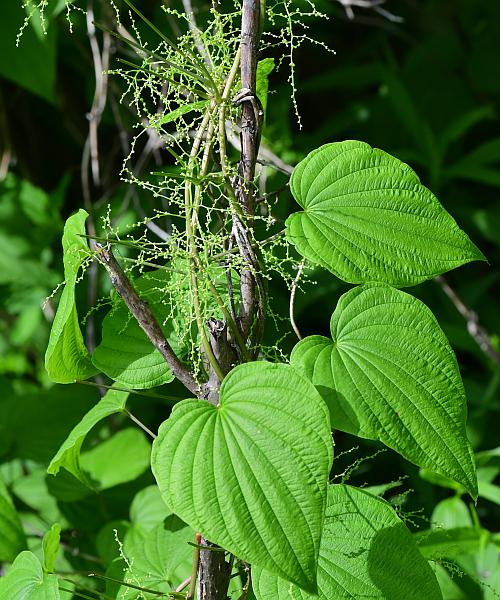Dioscorea villosa L.
Wild Yam

Native
CC = 5
CW = 0
MOC = 68
© SRTurner
Dioscorea villosa L.Wild Yam | |
 |
Native CC = 5 CW = 0 MOC = 68 |
© SRTurner |
|
Family - Dioscoreaceae Habit - Rhizomatous perennial forb, dioecious. Stems - Twining and climbing on other vegetation, to 5 m, usually angled or ridged. Rhizomes 5-10 mm in diameter when fresh, relatively straight and lacking in knobs.
Leaves - Alternate, possibly opposite or whorled near base, simple, entire, petiolate. Blades heart-shaped, 4-19 cm long, the bases cordate, the tips acuminate, the main veins 9-13, palmately arched from the leaf blade base and converging toward the tip, the smaller veins branched and forming a network between the main veins, glabrous or hairy.
Inflorescences - Staminate inflorescences axillary panicles. Pistillate inflorescences axillary spikes.
Flowers - Staminate flowers with 6 light yellow tepals 1-2 mm long and 6 stamens. Pistillate flowers with 6 light yellow tepals 1-2 mm long, 6 vestigial, nonfunctional stamens, and 1 inferior ovary 4-7 mm long with 3 locules. Styles 3 per flower, branched at the tip into 6 stigmas.
Fruits - Capsules, 3-winged, circular to broadly ellipsoid in outline. Seeds usually 2 per locule, flat, broadly winged.
Flowering - April - June. Habitat - Mesic bottomland and upland forests, frequently on mesic, rocky slopes, thickets along creeks, fencerows, railroad tracks. Origin - Native to the U.S. Lookalikes - D. quaternata, species of Smilax. Other info. - This species is very similar to the closely related D. quaternata, and distinguishing the two can be very difficult. Many botanists believe that they are the same species. Characters which may point to D. villosa include an angled aerial stem, leaves which are all alternate, and relatively slender rhizomes (5-10 mm diameter) with few or no knobs or side branches. The plants are common in the eastern continental U.S., with the range ending abruptly at a longitude roughly coincident with the western boundary of Missouri. Photographs taken at Weldon Spring Conservation Area, St. Charles County, MO, 6-24-2011, St. Joe State Park, St. Francois County, MO, 5-14-2012, Onondaga Cave State Park, Crawford County, MO, 5-28-2012, Shaw Nature Reserve, Franklin County, MO, 5-20-2022, and Gist Ranch Conservation Area, Texas County, MO, 6-9-2022 (SRTurner). |